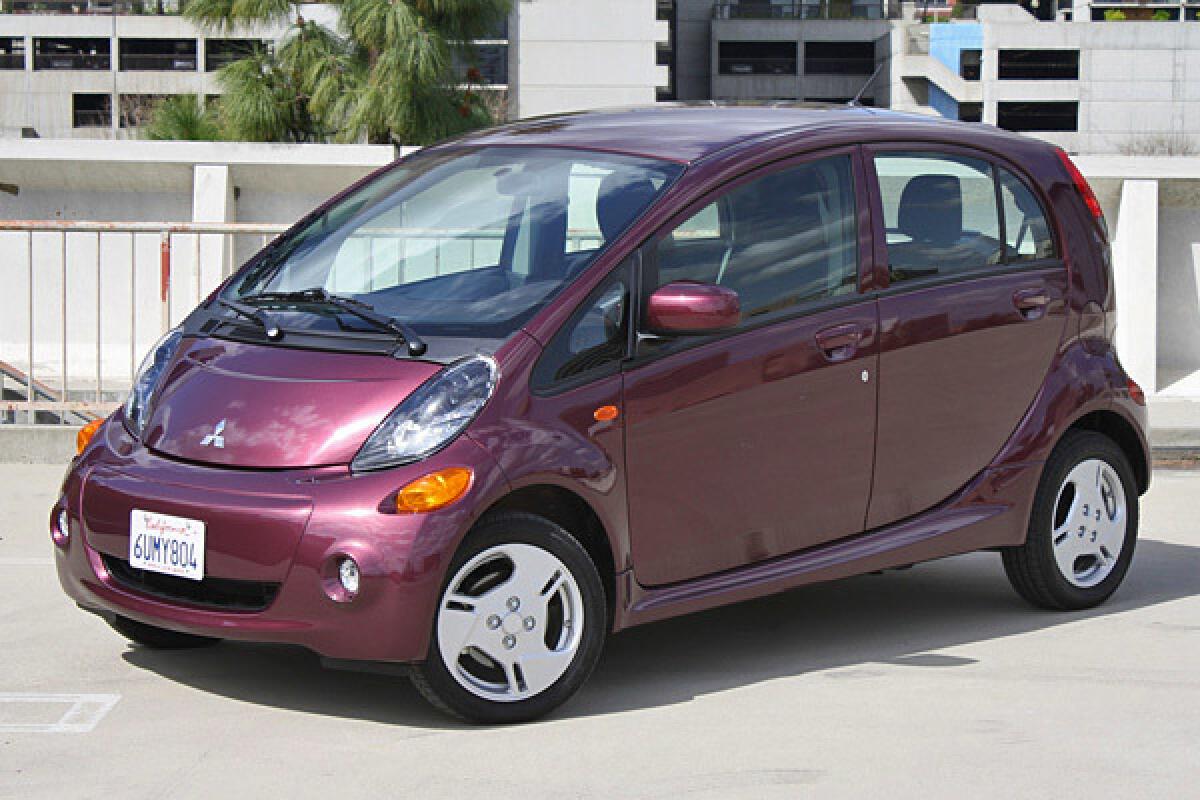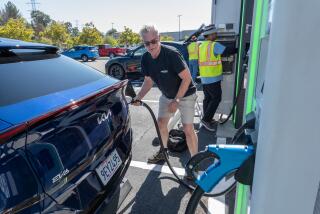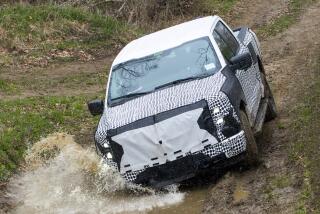Saturday Drive: 2012 Mitsubishi i SE

- Share via
The car: 2012 Mitsubishi i SE
The power: 66 horsepower and 145 pound-feet of torque coming from a 49 kW AC synchronous electric motor that’s powered by a 16 kWh lithium-ion battery. It routs power to the rear wheels via a single-speed transmission.
The speed: 0-60 mph in a long weekend (13.4 seconds)
The bragging rights: Cheapest and most efficient electric vehicle currently on the market. Expect a 62-mile range from a fully charged battery, which comes with an eight-year, 100,000-mile warranty.
The price: Base price is $31,975 including destination. As tested, $34,765. Both prices exclude a federal tax credit of up to $7,500 and possible state rebates.
The details: Looking and driving like the world’s most elaborate golf cart, the Mitsubishi i you see here is a ‘Mericanized version of the i-Miev electric car that’s been on sale in Japan and elsewhere in the world for about two years now (which, in turn, is based on the tiny Mitsubishi i gas-powered car that’s been hot in Japan since 2006).
To make the very pill-like car easier for a U.S. consumer to swallow, Mitsubishi stretched it by almost 8 inches and made it a little more than 4 inches wider. All told, it’s roughly in the size department of a Mini and a few inches longer than a Fiat 500, but offers a real, usable back seat because the mechanical packaging on the i is much more compact (the battery is below the floor).
Thus, people approaching tall can sit in relative comfort in the back seats without too much leg discomfort. Headroom is applaudable. The rear seat backs are split 50-50 and fold nearly flat for added cargo room. With them up, there’s plenty of room for a pile of carry-on suitcases, if you load them wisely.
The seats themselves aren’t much to write home about. They’re basic, cheap and put comfort far below economics. Same for the rest of the interior. Hard (nay, cheap) plastics are favored over anything remotely endearing and indicate that this is a vehicle whose primary goal is to get you from Point A to Point B efficiently as possible. Even an armrest for the driver is omitted. Must one suffer so in the name of energy independence?
The SE model tested here added items like 15-inch alloy wheels; a 360-watt stereo system; leather-wrapped steering wheel and shift knob; and foglights.
The car also had the optional premium package. For $2,790 buyers get items like a hands-free telematics system; backup camera; a quick-charge port for public charging from low battery to 80% in about half an hour; and a battery warming system that allows owners to warm up the battery when the car is still plugged in for more efficient motoring in cold weather.
Without that quick-charge option, owners have two other ways to power their car: a 240V home-charging station that needs seven hours to fill her up or a standard 120V cable that needs 22.5 hours to charge the battery fully. I used the 120V option to charge it at home and it took about 20 hours to bring the batteries to full capacity.
The premium package also includes a 40 GB hard-drive navigation system with real-time traffic updates. While it’s plenty useful, its integration into the current range of the i’s batteries was conspicuously absent. Nissan’s Leaf EV does a great job of showing drivers on its standard navigation system the range of the car, and the immediate effect that actions like turning on the air conditioning have on one’s range. A similar system on this Mitsubishi i would be a very useful feature, especially to consumers still adjusting to driving a car with an actual, finite range.
The drive: Did I mention that this is an elaborate golf cart? Since it’s designed for urban living, it may be unfair to ding the i for its less-than-stable freeway cruising. It’s nothing alarming, but it’s hard not to feel like you’ve just driven off the 18th green at Bushwood Country Club and straight onto the 405. The car can hit 80 miles per hour, though.
City driving is this car’s forte and it does it with the quiet, smooth manners that are hallmarks of electric vehicles. It’s easy and comfortable to navigate around town and its diminutive size make for easy parking in tight spaces.
Turning the car with a little speed in your gait, however, reveals a little too much body roll for my comfort. This is despite the fact that one of the key reasons for the battery’s placement under the floor is to keep the car’s center of gravity as low as possible.
The i’s single-speed transmission has three modes of operation. “D” gives drivers full power and performance at all times. “Eco” limits the amount of power available for longer range. “B” goes bonkers on the regenerative braking the moment you take your foot off the gas, even if you’re not yet using the brakes. This allows the car to slow down while simultaneously charging the battery and is most appropriate for traveling downhill.
Over my four-day test of the car, I drove it 44 miles and had an additional two miles estimated in my range before the battery was completely drained. Though this is a bit lower than the 62-mile claimed range, keep in mind that my 80-mph speed test is probably an outlier for the car’s prescripted use.
Though Mitsubishi touts the i as the most affordable EV in the U.S., consider that the model I tested was only $1,285 less than a comparably equipped Nissan Leaf before you consider tax rebates or incentives for either car. If it’s my wallet used to buy one of these, I’d aim for the Nissan. It’s much more of a complete car that happens to run on electricity rather than gasoline. This Mitsubishi just makes too many compromises to justify its initial asking price.
More to Read
Inside the business of entertainment
The Wide Shot brings you news, analysis and insights on everything from streaming wars to production — and what it all means for the future.
You may occasionally receive promotional content from the Los Angeles Times.











